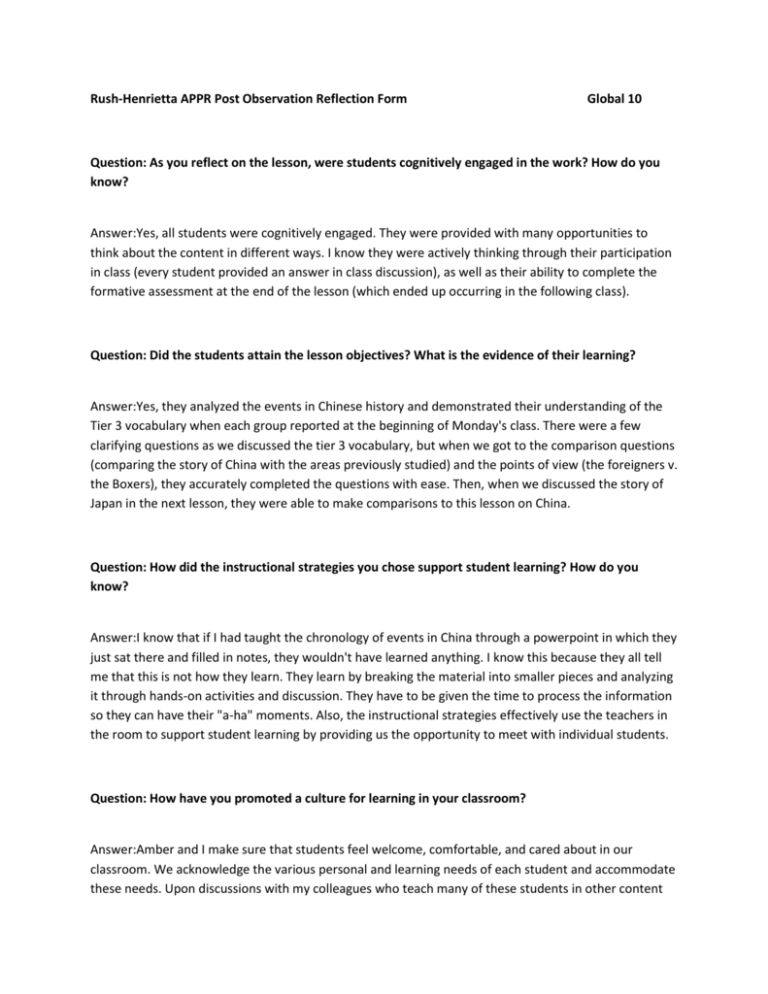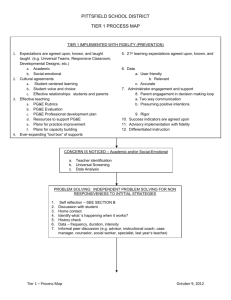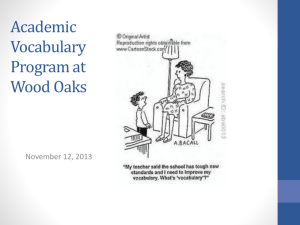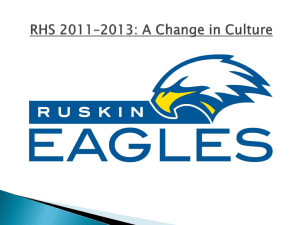Rush-Henrietta APPR Post Observation Reflection Form Global 10
advertisement

Rush-Henrietta APPR Post Observation Reflection Form Global 10 Question: As you reflect on the lesson, were students cognitively engaged in the work? How do you know? Answer:Yes, all students were cognitively engaged. They were provided with many opportunities to think about the content in different ways. I know they were actively thinking through their participation in class (every student provided an answer in class discussion), as well as their ability to complete the formative assessment at the end of the lesson (which ended up occurring in the following class). Question: Did the students attain the lesson objectives? What is the evidence of their learning? Answer:Yes, they analyzed the events in Chinese history and demonstrated their understanding of the Tier 3 vocabulary when each group reported at the beginning of Monday's class. There were a few clarifying questions as we discussed the tier 3 vocabulary, but when we got to the comparison questions (comparing the story of China with the areas previously studied) and the points of view (the foreigners v. the Boxers), they accurately completed the questions with ease. Then, when we discussed the story of Japan in the next lesson, they were able to make comparisons to this lesson on China. Question: How did the instructional strategies you chose support student learning? How do you know? Answer:I know that if I had taught the chronology of events in China through a powerpoint in which they just sat there and filled in notes, they wouldn't have learned anything. I know this because they all tell me that this is not how they learn. They learn by breaking the material into smaller pieces and analyzing it through hands-on activities and discussion. They have to be given the time to process the information so they can have their "a-ha" moments. Also, the instructional strategies effectively use the teachers in the room to support student learning by providing us the opportunity to meet with individual students. Question: How have you promoted a culture for learning in your classroom? Answer:Amber and I make sure that students feel welcome, comfortable, and cared about in our classroom. We acknowledge the various personal and learning needs of each student and accommodate these needs. Upon discussions with my colleagues who teach many of these students in other content areas, I know that I am getting a lot from them in my classroom. They consistently come to class on time, ready to learn, and participate a lot throughout class. Also, they work hard in homeroom on Global. They know that Amber and I believe that they all can learn, and that we expect them to be learners. Question: Did you make adjustments to your plan as you taught the lesson? What, how, and why? Answer:Due to time constraints, I was unable to finish the entire lesson and had to finish it the following class. Also, I made a mistake in my pre-observation form with the Tier 3 vocabulary group activity. In my pre-observation, form I said they would be in groups of 3 to look at a specific Tier 3 vocab term. However, due to a few absences, I ended up adjusting and making some of the groups with just 2 members. Question: If you were to teach this lesson again, what might you do (if anything) differently? Answer:I would love to pace the lesson so that we can get through at least the tier 3 vocabulary. I also should have had dates for each of the tier 3 vocabulary so they could see it as a time line of Chinese history. Question: Any other thoughts you would like to share about this lesson? Answer:This lesson reflects my growth as a teacher. I want every lesson to be student centered. My instruction, activities and resources are planned and organized to ensure that every student can attain the learning goals. Also, this lesson demonstrates the collaboration I consistently use in planning my lessons. Amber, her student teacher, Jen Sherman and I each contributed to the variety of learning strategies in this lesson. I am proud of the work I am doing.









